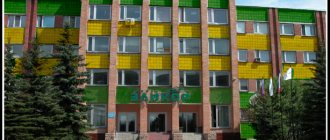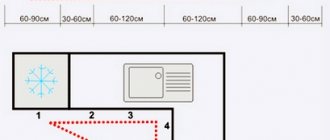Consequences of lack of ventilation
If you do not take into account the need to equip the room with proper ventilation, this can lead to the formation of mold and the appearance of an unpleasant odor, and in the future, due to dampness, the service life of finishing materials will be reduced and the appearance of the balcony will deteriorate.
Mold spoils the appearance of a room and is harmful to human health. Many people think that it is enough to ventilate their loggia or balcony, but this is not always the case. Ventilation is a temporary measure while the windows are closed. If there is a large difference in the air, water will flow through the windows, therefore, the humidity will be higher than all permissible standards. In glazed balconies you need to install a ready-made ventilation valve or diffuser; you can make an air exchange system yourself.
Is it possible to smoke on the balcony of your apartment in an apartment building
Most smokers know that smoking in public places is prohibited. But here a reasonable question may arise: what does my balcony have to do with it? The balcony is private property. Is it really possible to proudly call it a “public place”?
The whole point is that the smoke from cigarettes scatters several meters around. He can easily penetrate through the windows into the apartments of people living nearby. Which means it can harm them. Regardless of what views you hold on the issue of smoking in public places, one thing is clear - passive smoking is dangerous. In addition, non-smokers find the smell of cigarettes disgusting. Especially if this smell appeared in the apartment due to the fact that someone was smoking on the neighboring balcony. Therefore, some residents of apartment buildings may have a counter-question: neighbors are smoking on the balcony, what to do?!
Do-it-yourself ventilation on the balcony
To ensure proper air circulation in the room, you can purchase a ready-made hood or do the ventilation yourself. Ventilation on the loggia, done correctly, will help get rid of many problems. The question immediately arises of how to make ventilation on the balcony so that it works effectively.
To do this, you need to provide for the ratio of fan power and room area, and you also need to take measures to insulate the balcony.
Where to complain
If tobacco smoke gets into, for example, the windows of an apartment, it is advisable to file a complaint with the territorial body of Rospotrebnadzor (Article 21 of Law No. 15-FZ of February 23, 2013), in which it is necessary to describe the situation in detail and attach evidence. For example, you can cooperate with your neighbors, whose windows are also filled with smoke, film the act of smoking, etc.
Such a video recording will subsequently help prove your position in court, the lawyer advises.
The smoker will be fined under Art. 6.24. Code of Administrative Offenses of the Russian Federation. The fine ranges from 500 to 1500 rubles.
You can also file a claim in the district court for compensation for harm caused to health and moral damage. Remember that by virtue of Article 56 of the Code of Civil Procedure of the Russian Federation, each party must prove its position. To prepare for the trial, it makes sense to try to conduct an examination to confirm the presence of tobacco smoke in the air in your apartment.
If you live in a communal apartment and a neighbor smokes, for example, in the kitchen or on the balcony, this will be considered a violation. In this case, you should contact the police. You should also complain there about smokers in the entrance, elevator or other common area and insist on drawing up a report on an administrative violation.
How to make ventilation on the balcony with your own hands
Don't forget that warm air rises to the ceiling.
Therefore, the exhaust part of the ventilation must be located in the upper part of the room. Ventilation system installation steps:
- You will need two fans of the same power. One will work for the flow of air, the second will promote the outflow of moist air.
- To install ventilation in a room, it is necessary to install electrical wiring and sockets.
- We make holes for fans at the top and bottom of the outer wall. Using a hammer drill, we drill holes along the contour of the fan, then knock out a circle of concrete. We install the fan in the hole, secure it with silicone, and connect the electrical wiring to it.
The finished hood is easy to use.
When using fans without covers, you need to make them removable, otherwise cold air will flow through them on frosty days. For the winter, we take out the fans and cover the holes with foam plastic.
The second option is to nail plywood, this will prevent cold air from entering the room.
You can purchase a ready-made hood and install it on the balcony. This is the cheapest option and very easy to install.
The best option is to purchase ready-made fans with covers.
Natural ventilation
In winter, it will be enough to simply ventilate the balcony by opening the windows for a short time.
The condensation will disappear within 5-10 minutes. Natural ventilation includes airing. For it to be effective, it is necessary to order windows with a built-in micro-ventilation mode; it is inexpensive and the effect will be good. Micro-ventilation means that when you turn the handle, a small gap is formed between the window frame and the sash. Thanks to this mode, cold air practically does not enter the room, but at the same time air circulation is created.
Windows with step-by-step ventilation are also manufactured; it includes three tilt steps. You can adjust the degree of window opening depending on the season.
Hood on the balcony
In the form of a hood on the balcony, you can use a diffuser that regulates the air supply or a grille. The disadvantage of the grille is that in winter cold air will pass through it; you will have to seal it for the winter period. Using a diffuser, you can adjust the degree of air passage or completely stop its supply. To learn how to make ventilation on a balcony or loggia, watch this video:
Diffusers are available as exhaust and supply, adjustable and non-adjustable. Adjustable diffusers have a device that operates like a blind. Depending on the inclination of the plates, the degree of air passage is adjusted. Exhaust diffusers are recommended for smokers; they quickly remove smoke from the balcony if you smoke near the diffuser.
A hood on the balcony will create air flow and help keep the appearance of the room in perfect condition.
Using diffusers
The easiest way to do this is to install a diffuser or grille on the loggia. The grille will simply let fresh air in from the street. But again, in winter, cold air will penetrate through this hole. Therefore, in this case, the grille is usually sealed on the outside.
But if you install a diffuser, there will be no such problems. The fact is that the design of the diffuser both regulates the air supply and completely blocks the flow, which, of course, is very convenient in practice.
There are supply and exhaust diffusers. If the device is adjustable, then there are blinds inside them, and they help change the direction of the air. They are made of metal or plastic. Plastic ones are good because they don’t rust, but metal devices come complete with an anti-vandal system.
Diffusers are special ventilation devices that provide the ability to regulate air exchange, up to its complete blocking. Manufacturers today offer a fairly large selection of exhaust, supply or adjustable diffusers. If the first two types are capable of passing air flow in only one direction, then adjustable devices are capable of changing the direction of action.
You can find plastic and metal diffusers on sale. Each of them has its own strengths. For example, the advantage of plastic diffusers is that they do not rust. At the same time, metal diffusers almost always have anti-vandal properties.
Diffusers should be installed in places designated for this purpose. In this case, full compliance of the shape and size of the device with the exhaust duct must be achieved to ensure its strong fixation. Depending on the model, the diffuser can be attached with special latches, anchors, glue or self-tapping screws.
Ventilation valves
There are ready-made supply exhaust ventilation valves, which are a thin long structure that is installed on windows or walls.
They do not require electricity; they are manually controlled and provide air circulation. Advantages:
- They provide good air circulation and prevent noise and dust from entering the room.
- They favor the creation of a healthy microclimate and do not allow the development of mold and fungi that are harmful to the human respiratory tract.
- They act as a barrier to the passage of strong currents of cold air.
- The room is ventilated with the window closed, this is true on the first floor. Keeping the windows closed reduces the risk of intruders entering your home.
- Thanks to the reduction in humidity, all finishing, construction materials, and furniture on the balcony will last much longer.
Types of exhaust valves
Slot valve operation diagram
Valves are divided into types, depending on the method of installation and control. Depending on their device, they can be electrical or mechanical.
Valve classification:
- Seam dampers are installed on a previously installed balcony frame; they allow a small amount of air to pass through, preventing cold and noise from entering the room. They are installed in window cutouts and have a fairly low cost.
- Slot valves are manufactured with mechanical and automatic control. The passage of air is ensured by a channel measuring 170 mm x 400 mm; it can be universal or accommodate outdoor and indoor units. The outdoor unit lets air into the room, and the indoor unit releases humid air outside. Provides high-quality air circulation, suitable for installation on a finished window.
Supply valves serve to suck air into the room and are regulated mechanically and automatically. To learn how to install a valve on a window, watch this video:
Exhaust valves serve to remove moist air to the street, prevent air from penetrating back into the room, they are a barrier to the entry of dust, fluff, and insects.
Manufacturing stages
sends out a free measurer. You can come to the office to sign the contract, but if necessary, you are free to do all this directly on site with our manager - save time. The specialist will also collect information about the building and pass it on to the engineers.
They will create a project
It will contain title pages, diagrams with basic and detailed data, an action plan for employees, and other things. Drawings of integration with existing technology in the building are also created. All documents are certified by specialists, licenses from government agencies and other permits are obtained.
An estimate is being prepared. At this stage you can make changes to the price. At the end, the craftsmen will be provided with precise instructions and explanatory notes. Installation will begin.
Specialists will install and configure the hood in the hookah bar
They will drill into the walls in the right places. The channels and pipes will be secured. After this, electrical devices will be installed and connected. When all processes are completed, the testing phase will begin.
Here the components are visually checked. Next, the network is turned on, and specialists take measurements to ensure tightness, correct operation of sensors, etc. In the end, the installed system is subjected to increased loads. After making sure that everything is fine, the craftsmen hand over the work.
How to get rid of tobacco smoke
In practice, several methods are used to create a normal microclimate for people who are forced to be near smokers.
- Use of air purification equipment.
- Fencing the smoking area.
- The use of hoods with the removal of contaminated air into the ventilation system.
- Creation of specialized room ventilation systems.
Each of the methods has been tested in practice and has the right to life. Next, we will consider each method, its advantages and disadvantages in more detail.
Air purifiers
You can clean the air in a single room using devices equipped with specialized filter elements, devices that purify the air mixture at the molecular level. Equipment that can be used to get rid of the smell of tobacco smoke includes a regular kitchen exhaust hood, as well as a portable hood for smoking at home.
- Air purifiers equipped with carbon electrostatic filters will effectively clean the air mixture from the smell of tobacco only in case of prolonged operation in a closed room. The cost of carbon filter elements, depending on the model of the device, is quite high, so replacing them regularly will make the smoker happy.
- An air ionizer can clean the air masses of a small and enclosed room from contaminants. Without going into technical details, tar and nicotine in the air, under the influence of ions, lose their volatility and settle on the floor. What happens next: after turning off the device, all contaminants, under the influence of air currents that are present in each room, will inevitably enter the lungs and blood.
Hoods
Most of our compatriots believe that using a hood completely eliminates the consequences of smoking at home.
- A kitchen hood for removing smoke will only be suitable if the smoker is strictly under it. And then the smoke will partially have time to mix with the air masses in the room.
- Portable hoods built into ashtrays are a brilliantly useless invention by entrepreneurs from the Middle Kingdom. It is pointless to describe the operation of the device, since the area of the carbon filter and the fan performance of this device are too small to prevent the mixing of tobacco smoke with the air masses of the room.
In addition, modern industry produces a lot of products labeled “Eliminates the smell of tobacco.” In fact, the lion's share of such products do not remove, but only mask the unpleasant odor, filling the air masses with pleasant aromas.
Zoning of premises
Owners of entertainment establishments cannot always completely isolate the smoking room from other premises. In such cases, the principle of zoning is applied: this is the division of a large room into two zones. In one, smoking is allowed, in the other it is prohibited. The separation is not carried out due to partitions and the correct direction of air masses. Schematically, the principle of ventilation looks like this:
The principle of operation of ventilation when zoning a room
The supply ventilation air intakes are located in the non-smoking area. Hoods are installed in the smokers' area. The air flow passes through the first zone, pushing warm tobacco smoke to the hoods, and through them it is removed into the atmosphere. The air flow speed is 0.7 m/s, the direction of movement is only towards the hoods.
Smoking areas are equipped with additional air conditioners with a separate electrical circuit for connecting to the general network, and the staff workspace is equipped with local fresh air ventilation.
The installation of ventilation for smoking rooms for one or more halls, as well as hookah lounges, requires specific knowledge, a well-designed project, and experience in this field. provides services for designing ventilation systems in Moscow and the region, as well as neighboring regions. For any questions, please contact our specialists. You can find communication channels on the “Contacts” page.
Creating a fence
Protecting the smoker's space is the most effective solution, especially in combination with proper ventilation. The only drawback of this method is the difficulty in practical use at home. Protecting smokers from people who do not have the habit of inhaling nicotine combustion products has a trade name - smoking rooms. As a rule, they are equipped with a powerful hood for the smoking room, which removes polluted air into the atmosphere through a separate air duct.
You can create an improvised fence using air curtains. This is a fairly effective solution that requires accurate and quite expensive calculations of the required quantity and power of equipment, the aerodynamics of air flows, and the combined operation of ventilation and heating. In addition, zoning space using air curtains is more expensive to operate than creating a physical fence made of plastic and double-glazed windows.
Construction portal No. 1
12/08/2018 admin Comments No comments
The population density of cities, and, consequently, the interests of various groups constantly intersect. Smoking and people who use tobacco should not be a problem for others. At the same time, infringing on rights and pushing smokers out of urban areas is not a way out of the situation. In many public buildings, theaters, restaurants, cafes and snack bars, separate smoking rooms have appeared. Don't forget about hookah bars. Ventilation of a smoking room is the basis of its functioning. Tobacco smoke should not spread beyond the fenced area, causing inconvenience to non-smokers.
Proper ventilation of smoking rooms
The main mistake of everyone who independently tries to create smoking rooms in restaurants, hotels, and offices is to equip the premises with a powerful hood, completely forgetting about sufficient air flow. The strong vacuum created by exhaust devices makes a person’s stay in the smoking room uncomfortable.
Based on existing standards, during intensive smoking, from 70 to 140 m3/h of fresh air per person should be supplied to the room. That is why mechanical supply and exhaust ventilation must be installed in smoking rooms. To prevent the flow of contaminated air mixture into clean rooms, it is necessary to create a reduced pressure in the smoking room in the range of 5 to 10 Pa in relation to adjacent rooms.
The most competent solution is to install a hood for the smoking room, the performance of which will be 10-15% higher than the inflow. Supply air in the required volume is best supplied through grates in the floor.
This ventilation system works like this: while tobacco smoke has a higher temperature than the air in the smoking room, it rises. Next comes the zone of “temperature equilibrium” and tobacco smoke hangs in the air. Supply air masses supplied at a speed of 0.5 - 0.7 m/s through grilles installed in the lower part of the room will evenly displace smoke from the room through exhaust holes located in the ceiling of the smoking room.
Drawing up a project and accurately calculating ventilation in a smoking room requires specific knowledge and experience. That is why it is necessary to trust the creation of a competent ventilation system in such premises only to professionals. Video about assembling smoking rooms:
ventilationpro.ru
And in apartment buildings, usually one or two general ventilation stations pass through each apartment.
Bugagashenki. You have been cruelly deceived. General exchange ventilation ventilation provides for forced inflow and exhaust with a certain air exchange rate. Sorry, but these “one or two risers” (and in general, what did you mean by riser? Maybe I’m not talking about that at all?) So these one or two ventilation shafts, which under certain conditions can play (and, as a rule, play ) the role of passive hood. And no more.
And yes, you can also hang a powerful hood on it and smoke in your apartment.
Can. But if you did this in my house and at the same time lived below, then I would make a lot of efforts to find you and wean you off smoking once and for all.
As usual - through house ventilation, wooden frames of other rooms, keyholes, slightly open windows - ten cubic meters of air per hour instead of those blown out by the hood on the balcony - not a problem either from the point of view of “where will they come from”, or from the point of view of “how do they will warm up."
About home ventilation, see above. If you do manage to create a sufficient exhaust flow on the balcony (which I very much doubt) in order to begin to suck from the ventilation shafts into the apartment, then again, I highly doubt that you will like it. Because air will be pulled into your apartment from the kitchens and toilets of your neighbors. Do you need it? To smoke on the balcony with the door open and not have the apartment stink, take my word for it - you will need a fairly powerful hood. And if you organize an influx through an open window in another room, you will freeze the apartment very quickly.
Well, I repeat that with some assumptions, any option can be considered acceptable - as long as you like it and are satisfied. I just expressed my opinion about what is needed in order for it to be normal (not really ice, I’m just normal) in my understanding. After all, some smoke cigarettes in an apartment without any hoods or ventilation and consider this normal, so to each his own...
mycigars.org
Organization of ventilation in smoking rooms
Natural ventilation is not able to cope with the replacement of air volume necessary to reduce the maximum permissible concentration, therefore, only supply and exhaust ventilation with mechanical drive is installed in smoking rooms.
There are two principles of its operation:
- mixing followed by removal.
- complete replacement (replacement).
Let's take a closer look at each of them.
Mixing followed by removal
Characterized by a low air exchange rate. Supply and exhaust ventilation operates according to a moderate supply of fresh air in order to dilute smoke-contaminated air. Then the mixed mass is removed through general or local hoods.
This scheme has low efficiency: a significant percentage of tobacco smoke and waste combustion products remain in the air. If the room is divided into smoking/non-smoking areas, then part of the tobacco smoke pollutes the clean air without having time to be absorbed into the exhaust air intakes. The advantages include low cost of design, installation and equipment.
How to make ventilation?
Many people think that this issue can be solved simply by opening the window, but in winter such ventilation on the balcony is unacceptable, so it is better to use an air conditioner and then the problem will be solved by using a supply hood.
You can invite professionals for installation, but you can carry out all the necessary work yourself.
It is important! On the balcony, fresh air ventilation can be installed both at the top and at the bottom of the wall. But if the operation of one hood does not satisfy the owner, then one fan is mounted below and the other above. This placement will ensure natural convection, which will be supplemented, if necessary, by forced draft.
Tools and installation
For ventilation equipment on the balcony you need:
- Hammer or drill;
- One or two fans (from the computer).
Use a drill to drill a hole equal to the diameter of the hood. Since the balcony railing is often made of concrete, a hammer drill or carbide drill is used.
To activate air movement in the supply ventilation, a fan is inserted into both holes. In this case, one hood will blow out air, and the second will blow in.
If necessary, change the connection poles, and this changes the direction of movement of the fan. This system works as follows: from the bottom fan, air is blown out from the balcony room, and from the top, fresh air is blown in from the street.
In winter, cold air will flow into the balcony through the hood holes, and to prevent this from happening, you can make the ventilation system removable and cover the holes with something or make dampers.
They use plywood covered with foam or batting. The doors are secured with screws, but if you spend some money, you can buy fans with plastic doors.
The main mistakes when insulating a balcony
Since the apartment in an apartment building has a small area, the owners attach a balcony and a loggia to an adjacent room or to the kitchen. In order for the area obtained in this way to be useful, it should not be inferior to another room in its characteristics.
If you have installed a balcony and after some time mold appears in the corners and water appears near the wall, it means that mistakes were made during the work on insulating the room, such as:
When finishing the walls and floor, all the cracks and crevices were not sealed, and therefore there is draft on the balcony; If, when choosing slats and beams (for sheathing), you buy material that is not well dried, then it will become deformed.
The biggest mistake is the appearance of blackish-greenish mold and condensation, this can happen for the following reasons:
- Mistakes made when working on insulation;
- Incorrectly installed ventilation;
- Poor heating system.
If the hood on the balcony is not installed correctly, then air will flow from the warm side of the room to the colder part of the room and condensation and moisture will form on the coldest plane.
To prevent this from happening, it is necessary to ensure air exchange, for example: if you install a door that will divide the room into two parts with different humidity and temperature.
If the balcony insulation is not done correctly, then moisture will appear in that area, so it is necessary to follow the technological process of this operation.
For example, if instead of polyurethane foam you use gypsum putty and use it to seal the joints of the insulation, then moisture will condense on the “cold bridges” that will be created by the gypsum. You can’t fight this, and redoing it will be quite expensive.
In winter, moisture (steam) passes through the insulation, enters the room and collides with a cold wall, and, once on its surface, the steam condenses and turns into liquid. After a while, the insulation gets wet, and then the wall gets wet, and mold and mildew appear on it. Since nothing holds moisture, leaks form and the insulation loses its quality.
Methods for getting rid of condensation
We looked at how to make ventilation on a balcony with proper air exchange, and now we’ll look at another issue.
By using a vapor barrier, which must be installed in front of the insulation layer, you can get rid of condensation.
This method is used regardless of the vapor permeability of the material; foil or plastic film is used for it.
If foam plastic is used, which has low vapor permeability, then this method will have no disadvantages. However, you need to know that mineral wool cannot be used.
Depending on the climatic conditions of the region, thermal engineering calculations and local standards, the thickness of the insulation required for a particular case is determined. For expanded polystyrene, this value is 8 cm, and for extruded material - 5 - 6 cm.
In order to get rid of condensation, you need to raise the temperature on the balcony and reduce the humidity in the room.
To make the loggia warm, the double-glazed window is replaced with a double-chamber one, and if they want to overcome moisture, it is necessary that the supply ventilation on the balcony be installed correctly, that is, they provide an influx of fresh air and install an exhaust hood.
If you constantly keep the window sash ajar or use a special supply valve that is mounted on the window, then you can get rid of condensation.
Conclusion
If you follow all the recommendations and have not completely gotten rid of condensation, it means that not the entire room is ventilated or the hood is not installed correctly.
Therefore, you will have to increase the temperature on the balcony by installing an electric radiator or installing a “warm floor”. And then the problem with condensation and moisture will be solved, and the balcony will become part of the room and in the cold season it will be comfortable and cozy here.
Source: odnokomnatka.ru/kak-samostoyatelno-montirovat-ventilyaciyu-na-balkone.html
Ready-made schemes
Now let's look at schemes that can be used in practice. Some of them can be implemented with your own hands, others will require special skills and equipment.
We will consider the following options:
- Natural supply system.
- Forced supply system.
- Forced supply and exhaust system.
Below we will analyze step by step how each scheme is done correctly.
Natural, only influx
The simplest option that you can implement yourself. The flow of outdoor air can be carried out in any of the following ways:
- Through an open window/window.
- Through an open window with a comb.
- Through a closed window with a micro-ventilation system.
- Through the wall valve.
- Through the window valve.
The flow can be organized using any method from the section above. Air removal is carried out through the ventilation shaft and/or hoods (in the kitchen or in the bathroom/toilet).
Next, let's look at each option in more detail.
The method is the simplest and cheapest, but not always convenient. Along with fresh air, insects, poplar fluff, rain and snow can fly inside. In addition, all street noise will be perfectly audible (and those around you will hear the sounds from your apartment).
You can partially reduce the problem if you do not open the windows all the way, but open them slightly. But in this case, the noise will still be heard (albeit less), and less air will flow inside. Therefore, open windows are only suitable for ventilation in warm, dry weather, and if you live in a quiet place and/or on a high floor.
A comb is a plastic or metal retainer that connects the sash and frame, preventing them from opening more than necessary. This option is suitable if the window only opens completely, or if it does not open the required amount. Otherwise, this option has the same disadvantages as ventilation through an open window.
A better option is a micro-ventilation system. In this case, the window closes, but there remains a small gap between the sash and the frame - literally a few millimeters. It will be enough for air to enter, but at the same time rain will not pour through it, and insects will not be able to fly in. The downside is that the gap is too small, and even if there is micro-ventilation in every window, this is unlikely to be enough for the required amount of incoming air.
A wall valve is essentially a plastic pipe with a filter and a small cap (which can be closed as needed to block the air flow). It can be used if the thickness of the balcony wall is large enough. It simply cannot be inserted into a structure that is too thin (or it will have to be strengthened somehow). The advantage is that the product provides a sufficient amount of air - depending on the model, this can be 30 m³/h or more.
Ventilation on the loggia: how to make a hood on the balcony
The loggia is one of the smallest rooms in the apartment. When glazing with metal-plastic windows, ventilation on the balcony must be provided.
What can a lack of ventilation cause?
Otherwise, the following consequences may occur:
- The appearance of mold on walls and other surfaces;
- Constant condensation on the glass;
- Increased humidity and, as a result, an unpleasant putrid smell in the apartment.
Condensation forms due to the difference in temperature between the outside and inside the room.
Thermal insulation errors
Residents expand the space of their living rooms and kitchens by adding a balcony to the adjacent room. The technical characteristics and microclimate in both rooms must be the same.
The following signs indicate errors in balcony insulation:
The cause of such defects may be insulation flaws. If there are gaps between the ceiling and walls, in the floors, or on the balcony, drafts appear. This leads to dampening of materials and furniture due to cold air.
The appearance of water and condensation is caused by:
Moisture appears on surfaces that become colder. Ventilation allows you to equalize temperature and humidity. If the indicators on the balcony and living room differ significantly, high-quality air exchange will help to avoid such troubles.
Types of ventilation on the loggia, balcony
The simplest ventilation option is windows open in ventilation mode.
But this method is not suitable for winter and summer. In this case, in winter it will be cold on the loggia, and in summer it is undesirable to open the windows with the air conditioner running.
To ensure good air exchange between the street and the balcony, either automatic (forced) or mechanical (supply) systems are needed. If desired, they can be successfully combined, since each has its own advantages and disadvantages.
DIY forced ventilation
The easiest way is to install a fan on the balcony. For a large loggia, it is better to use two: one will take air from the street, and the second will return it. For a small balcony, one fan is enough.
Advantages of using a forced system:
- Efficiency;
- Ability to turn off as needed.
Flaws:
- Noise during operation;
- It is necessary to remove the fan for the winter and close the hole so that the hood on the balcony does not allow cold air to pass through.
Tools and materials required for work:
- Hammer;
- Fan;
- Fasteners;
- Dry plaster mixture;
- Sealant;
- Putty knife.
The device must be connected to the network.
DIY fan installation
Select a location for installation on the outer wall, and use a pencil to mark the diameter of the shaft.
Run an electrical wire there. Using a hammer drill in jackhammer mode, punch a hole in the wall and attach the fan to the balcony. Apply the plaster and use a spatula to carefully seal the wall around the device.
The next day, when the mixture has hardened, additionally coat the fan with sealant to prevent air from entering from the cracks.
In addition to using an electronic fan, there is the option of installing a regular computer cooler. You can buy it or remove it from an old non-working computer. The cooler does not require a separate connection; it can be connected to the lighting wiring. Thus, when you turn on the light on the loggia, ventilation will immediately start.
Varieties
Hygrometers are divided into several types.
- Resistive. Their principle of operation is to measure humidity inside the active medium of the device. The main sensitive element is polymer parts and substrates. The design of a typical resistive hygrometer involves the presence of a special substrate that carries a photoresistor and a pair of electrodes. On top they are covered with a conductive layer. Such a device operates approximately 30 seconds after a change in humidity, which is suitable for a living room or bathroom.
An important advantage of this type is interchangeability and no need for calibration. They are also durable and last on average about five years.
But the service life is reduced when working in unfavorable environments, for example, in vapors of chemicals, technical oils, and so on.
- Capacitive. Their main element is a capacitor. When the ambient air parameters change, the capacitance characteristic of the capacitor changes, triggering the sensor. The operating principle of such a gadget is called an “air-gap capacitor.” Air humidity affects its dielectric constant. As the level of water vapor changes, the capacitance of the capacitor also changes. There are also more complex options where the air is replaced by a dielectric layer; They are somewhat more accurate, but do not perform well with humidity levels less than 0.5%. Although in everyday use such values rarely arise, so the disadvantage is insignificant.
Thin film hygrometers with several additional temperature sensors for more accurate measurements and compensation for deviations are very popular. - Thermostatic. They have a different operating principle. A thermostatic hygrometer contains thermistors connected to each other. An increase in humidity leads to a directly proportional increase in the voltage value. There are two resistors inside the device - open and isolated. The temperature difference generates a difference in resistance across the thermistors, which serves as an indicator of humidity. These modules are mainly used in industrial and household appliances such as microwave ovens and dryers.
Possible additional functions:
- activation by motion sensor so that ventilation starts only when a person is present;
- ventilation - start the fan in “quiet” mode;
- timer - work for a few minutes after taking a bath to quickly dry the air;
- equipped with a check valve. It prevents the penetration of unpleasant odors, dust and other particles;
- additional decorative lighting;
- power setting;
- clock on the front panel, and others.
How to make ventilation on a balcony as simple as possible
If it is not possible to install a fan on the balcony, the best solution is a supply air system. Most often there are 2 types used: window ventilation valve or diffusers.
Ventilation on the loggia using a window valve
A modern simple solution is to install a special valve on the top of a metal-plastic window. It is a PVC product in the form of a narrow box, which is inserted into the gap between the frame and the sash.
Its operating principle is simple - fresh air enters the duct channel from the street and then onto the loggia. The valve can be universal or consist of two blocks (external and internal).
The advantage of such ventilation is its low cost, the disadvantage is that it is not suitable for every window structure or requires violating the integrity of the metal profile.
Diffusers and grilles
The easiest way is to install a grille or diffuser on the loggia. The grille will simply let fresh air from the street into the loggia. The disadvantage of this solution is that in winter cold air will pass through it, you will have to take measures and seal the grille on the outside.
But if you install a diffuser, then there will be no problems in winter. The diffuser design involves adjusting the air supply, as well as completely blocking the flow.
There are two types of diffusers: exhaust and supply. Adjustable devices have blinds inside, with the help of which you can change the direction of the air. They are made of plastic or metal. Plastic ones do not rust, and metal ones are equipped with an anti-vandal system.
Diffuser installation
You will need a hammer drill, plaster, and sealant. The installation principle is the same as for a fan:
- Make a hole in the wall.
- Secure the diffuser with plaster.
- Apply sealant to the joints around the edges.
Source: me-remount.ru/balkon-i-lodzhiya/remont/ventilyatsiya-na-lodzhii.html
Implementation methods
Ventilation systems can be roughly divided according to 2 criteria:
- In the direction of the air flow - will air be supplied in or removed?
- According to the method of organizing air exchange - will fans be used (forced system) or not (natural system)?
Below we will briefly consider the principles of each option. For detailed installation diagrams, see the next section.
By air direction: supply or exhaust?
Hoods are very rarely installed on balconies and loggias - usually this is necessary if this room is used for smoking, or if there will be a barbecue on it. In most other cases, an inflow is organized on the balcony.
From the balcony, fresh street air will pass into the room and be removed from it - through the openings of ventilation shafts or hoods (kitchen, bathroom).
By the method of organizing air exchange: forced or natural?
- Natural system - air will be supplied and removed without fans, through holes.
- Forced system - air will be supplied and/or removed using fans.
Natural ventilation is good for its simplicity - it does not require any electrical equipment. But it also has significant disadvantages:
- air exchange according to this scheme is unstable, and largely depends on the weather and the performance of ventilation ducts (which often work poorly when it comes to high-rise buildings);
- The air exchange rate cannot be adjusted.
Forced ventilation does not have both of these disadvantages - regardless of weather conditions, the required air exchange rate can be ensured. Such a system will be more expensive to install, and in terms of installation it will be more complex than a natural one.
About the obligatory nuance: flow between the balcony and the room
Mandatory rule for each scheme : air must pass between the balcony and the adjacent room without obstacles. That is, you cannot simply make an influx into the loggia, but at the same time close the windows and doors tightly and not worry about the flow of air in any other way - in this case, all the problems will remain.
Transfer grille in the door
You can organize flow in the following ways:
- Through an open balcony door or window.
- Through the transfer grille in the door.
- Through the gap under the door leaf (an undesirable option, since the gap cannot be quickly closed if necessary), unlike other points).
- Through a window/wall valve.
- Through a supply air installation in the wall (in this case, street air will flow to the balcony much better due to the installation’s fan).
Ventilation on balconies and loggias: making an exhaust hood
It is not for nothing that three engineering systems - heating, ventilation and air conditioning - are grouped into one section in construction estimates.
Yes, and SNiPs also combine descriptions of the requirements for their construction and installation.
Properly installed heating appliances, the presence of an influx of fresh air and its timely intake through the hood are indicators of their operation that make it possible to create a comfortable microclimate in the apartment.
What about the loggia and/or balcony? It is in these unheated rooms that problems arise, which we will try to sort out.
What determines the correct microclimate of a loggia/balcony?
Probably, any person has paid attention to the modern houses being built. A beautiful facade, large balconies, the presence of loggias - pleasing to the eye! But, basically, the construction project does not include glazing and insulation of these premises.
The owners, if desired, do this themselves and start with glazing, believing that with this they have solved all the problems - heat conservation and sound insulation. But for some reason the windows began to “cry”, and the tightly closed room became quite damp. This situation also occurs in old houses, where instead of wooden balcony frames, new sealed metal-plastic ones are inserted.
On the one hand, the issue with heat loss has been resolved. But dampness, musty smell, fogging of windows, mold appeared. Why is this happening? The structure of the wood and natural gaps in the frames did not interfere with the passage of air to the balcony or loggia.
Plastic windows do not allow fresh air to pass through, but humid, exhaust air, saturated with carbon dioxide, enters this room from other rooms and the kitchen. Condensation occurs due to clothes drying on the balcony and flowers.
Such a concentration of harmful air in a room that should be ventilated “by default” is unacceptable. It negatively affects not only building structures, furniture and other objects, but also human health. Therefore, proper insulation and ventilation on the balcony or loggia are necessary.
How to arrange loggia ventilation
So, when deciding on repairs to the loggia (insulation, replacement of glazing), it is necessary to plan a ventilation device.
If anyone thinks that opening a window for ventilation will solve the problem, he is deeply mistaken. In winter, frequently opening the window in an already very cold room will only worsen the situation.
First of all, you need to decide on the type of ventilation for the loggia. The choice should fall on one of three existing systems:
- natural;
- forced;
- mixed (supply or exhaust).
Natural ventilation
Does not involve installation of any equipment. But still, for its functioning it is necessary to take into account some points:
- When insulating a balcony that does not have heating, you cannot completely block the access of air to the walls of the room. To do this, when installing insulating and facing layers on the walls, near the ceiling and near the floor, leave a gap of at least 50 mm;
- all materials used for insulation must be waterproof.
The principle of operation of such ventilation is the influx of fresh air from outside and the removal of exhaust air through ventilation ducts located in the sanitary rooms and kitchen. Obviously, such air exchange is unacceptable, since air saturated with moisture from drying clothes or, for example, cigarette smoke should not enter living rooms.
Forced air exchange
If the owners of the apartment plan to use the balcony for smoking, then they cannot do without forced exhaust. The inflow can be organized by installing window valves on movable sashes.
Well, if the loggia or balcony is large and it is supposed to be actively used, then it is possible to install a recuperator. This is very effective, but quite expensive equipment.
Where is smoking allowed and where is it prohibited?
Federal Law prohibits smoking:
- In vehicles.
- The ban applies to areas located near the entrance to any train station. The clause is aimed at protecting the health of a large number of people. The concentration of people near train stations and airports is especially high.
- In places where passengers are disembarked and boarded;
- In children's educational institutions, on the territory of this institution.
- In places of leisure and recreation for people. These include public parks, waterfronts, water parks;
- In medical centers and on their territories;
- In public places that are intended for feeding people (restaurants, canteens);
- In territories owned by public authorities and local self-government;
- In work areas and where work is carried out.
- At transport filling stations;
- Where the use of this area is general. These are elevators, entrances, staircases.
Those who violate the law will be forced to pay for their actions.
The law does not ban smoking:
- In areas specifically designated for smoking, located outdoors or in rooms with constant ventilation.
- In air and motor vehicles transporting people over long distances (with air ventilation), bars, cinemas, open-air catering places.
- In multi-storey residential buildings that are equipped with a ventilation system. That is, the ban does not restrict smoking in your own home if it does not bother others.
If there are no schools, kindergartens, playgrounds, or hospitals near the entrance, then no one can interfere with your favorite activity.
Ventilation calculation
Due to the fact that balcony structures are used as verandas in private houses, the air in them must be clean and not oversaturated with carbon dioxide or humidity.
For these purposes, 3-fold ventilation of balconies and loggias is calculated. What does this mean? When calculating the ventilation system, take into account:
- The speed of air flow through ventilation ducts.
- Volume of the balcony structure.
- Multiplicity increased by 25% due to the ceiling level (set for this room - 6 m).
For an approximate calculation, we take the following data: length (a) – 3.5 m, width (b) – 1.5 m, height (h) – 3.0 m, air speed, according to SNiP 06/31/2009 Public buildings and structures – 1 m/s.
So, the volume of the room is V=abh=3.5x1.5x3=15.75 cubic meters;
Air exchange rate (6-3)x0.25+3=3.75;
Circulation, with increased multiplicity, for this room - 15.75x3.75 = 59.06 cubic meters.
Using the air flow table at a given speed, you can find out the diameter of the air duct. For this example it is 160 mm. You can also use the calculator for calculating air ducts and fittings available on our website.
Do-it-yourself ventilation on the balcony
The simplest way to create super-efficient ventilation is mixed. The inflow is provided by a window inlet valve.
This element will not break the seal of the metal-plastic window, but will allow fresh air to constantly flow onto the balcony. The hood must be equipped with an exhaust fan.
You can make a hood on the balcony that will work at any time of the year and in any weather by installing a recuperator. This installation combines the functions of fresh air supply, exhaust air removal, and heating of air masses.
What is important to know about ventilation with recovery
- Installation restrictions: nearby heating devices.
- Provides simultaneous influx of fresh and exhaust of humid, exhaust air.
- Purification of incoming air from dust and street pollution.
- The air masses entering the room are heated to 23°C due to the air masses escaping and the presence of a heater in the structure. This allows you to maintain a comfortable temperature in rooms such as a balcony or loggia in winter.
- The system dries the air, bringing it to standard levels.
The simplicity of design and installation allows even a non-professional to install ventilation on a loggia with recovery.











